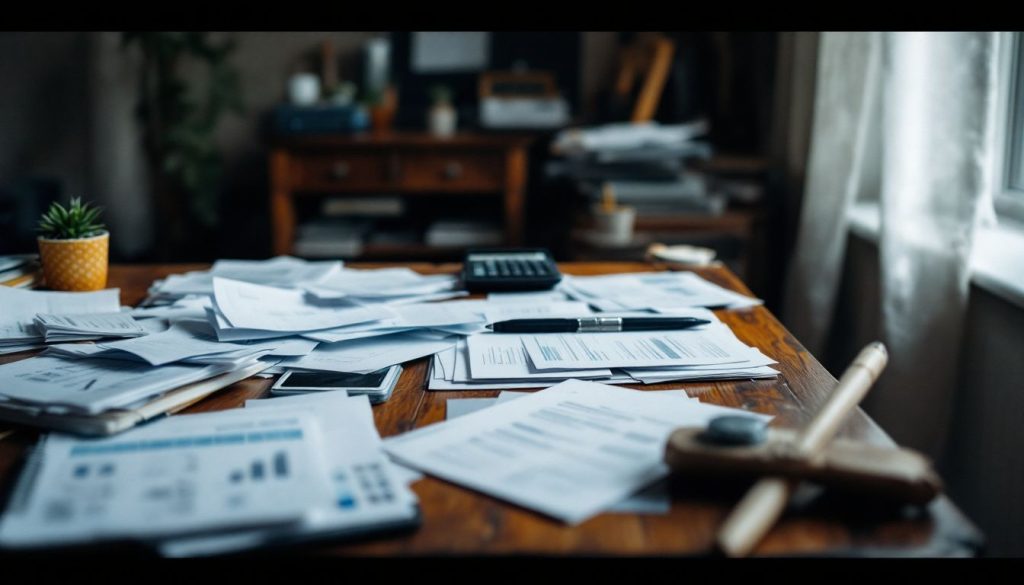Dealing with debt is hard. The Canada Revenue Agency (CRA) is a big part of the insolvency process. Our blog will guide you through filing for bankruptcy and solving debt problems with CRA.
Keep reading to learn more.
Key Takeaways
- Insolvency means you can’t pay your debts. Bankruptcy can wipe out most debts.
- The CRA Insolvency Department helps with tax debt issues. Licensed insolvency trustees guide you through the process.
- Filing for bankruptcy stops CRA from taking your money directly. It gives you a new start but may affect taxes.
- Dealing with CRA debts involves knowing your rights, talking to the CRA, and possibly making payment plans.
- Resources like the Bankruptcy and Insolvency Records Search Database help understand personal financial status and options.
Understanding Insolvency
Insolvency means you can’t pay your debts. It is a serious financial situation that can lead to bankruptcy.
What is Insolvency
Insolvency means a person or business cannot pay their debts. It is a legal status that helps people find relief from financial stress. The Bankruptcy and Insolvency Act outlines the rules for dealing with insolvency in Canada.
This law allows individuals to discharge most of their debts through bankruptcy.
Financial distress can impact anyone. When this happens, someone may file for personal bankruptcy to stop wage or pension garnishment by the CRA. A licensed insolvency trustee plays an important role during this process.
They help guide debtors and manage insolvency documentation effectively.
Bankruptcy offers honest debtors a chance for a fresh start.
Bankruptcy and Insolvency Act
The Bankruptcy and Insolvency Act is a key law in Canada. It allows people to file for personal bankruptcy. This legal process helps honest individuals who face financial distress.
Most debts can be wiped clean through this act. You can obtain a fresh start after declaring bankruptcy.
Filing under this act stops the Canada Revenue Agency (CRA) from garnishing wages or pensions. People have specific time frames to settle their debts based on their situation. Understanding this act and its implications is vital when dealing with CRA debts.
Seeking help from licensed insolvency trustees can guide you through the steps involved in the process effectively.
CRA Insolvency Department
The CRA Insolvency Department helps people who have tax problems. They offer support and resources for those facing insolvency issues.
Contact Information
You can contact the CRA Insolvency Department for help with your debt issues. They play a key role in the insolvency process and can assist with bankruptcy matters. Find their phone numbers on the CRA website or check local listings.
If you wish to make a complaint, follow the steps laid out on their site.
Regional Intake Centres are available across Canada. These centres provide support if you’re facing personal insolvency. You can visit them for guidance on handling debts to CRA and understanding your rights during this process.
Complaint Process
Moving on from the contact information, it is important to know how to file a complaint with the CRA. This process can help you if you face issues during your insolvency journey.
- Identify the Issue: Clearly state what problem you have with the CRA. This could be about debts, bankruptcy claims, or any other matters related to CRA services.
- Gather Evidence: Collect all relevant documents. This might include letters from the CRA, tax records, or emails that support your claim.
- Try Resolving Directly: Before filing a complaint, reach out to the CRA directly. Speak to a representative about your issue and see if it can be resolved informally.
- Check Complaint Procedure: Visit the CRA’s official website for information on their complaint process. They provide details on how to submit your complaint effectively.
- Use Proper Forms: Fill out any necessary forms that are required for submitting a formal complaint to the CRA. Ensure all sections are complete for smooth processing.
- Submit Your Complaint: Send your complaint along with supporting documents via mail or online through their website as directed in their procedures.
- Keep Records: Save copies of everything you send and receive back from CRA regarding your complaint. This documentation is crucial for future reference.
- Follow Up: If you do not hear back within a few weeks, contact them again for an update on your situation.
- Seek Additional Help if Needed: If your issue stays unresolved after this process, consider contacting the Office of the Superintendent of Bankruptcy or an Insolvency Trustee for more assistance in dealing with CRA debts.
- Be Aware of Deadlines: Always keep deadlines in mind when filing complaints or taking steps towards bankruptcy under the Bankruptcy and Insolvency Act to avoid further complications with creditors or liquidation processes.
Regional Intake Centres
Regional Intake Centres help Canadians with insolvency matters. They provide important services and information for those dealing with CRA debts.
- Service Locations: These centres are spread across Canada. Each centre serves different regions, making it easier for individuals to access help based on their location.
- Insolvency Guidance: Staff at these centres can explain the bankruptcy process. They guide individuals through the steps of filing for bankruptcy or seeking relief from CRA debt.
- Access to Resources: These centres offer resources like brochures and pamphlets. Useful information about insolvency documents and procedures is available here.
- Filing Assistance: They assist with paperwork needed for bankruptcy filings. This reduces confusion during a stressful time.
- Information on Trustees: Regional Intake Centres can connect individuals to licensed insolvency trustees. These professionals provide expert advice during the insolvency process.
- Understanding Rights: Individuals learn about their rights under the Bankruptcy and Insolvency Act at these centres. Knowing your rights is crucial when dealing with creditors like the CRA.
- Local Support Services: Many centres work closely with local support groups and organizations that help people in financial distress.
- Workshops and Events: Some locations host workshops on managing debts to CRA or understanding personal finance better, helping Canadians make informed choices.
- Confidential Help: All discussions at these centres are private and confidential, ensuring individuals feel safe while seeking help with their financial issues.
- Contact Information: Each centre provides direct contact information for easy access to assistance whenever it is needed during the CRA insolvency process.
These points highlight how Regional Intake Centres support Canadians facing insolvency challenges related to CRA debts effectively.
Filing for Bankruptcy with CRA
Filing for bankruptcy with the CRA can help you clear your debts. It is important to understand your eligibility and the steps to take in this process.
Eligibility
Eligibility for filing bankruptcy with the CRA depends on your situation. You must face serious debt issues and be unable to pay them. In Canada, you can file under the Bankruptcy and Insolvency Act if you owe at least $1,000.
Your debts should exceed your assets. This process helps honest people get a fresh start.
Filing personal bankruptcy stops wage or pension garnishment by the CRA. It also allows you to be discharged from most of your debts. Understanding these points is essential for those considering the CRA insolvency process.
Process
The filing process for bankruptcy with CRA can seem complex. Follow these steps for a smooth experience.
- Gather Your Financial Documents
Collect all your financial paperwork. This includes tax returns, pay stubs, and bills. Having these ready will help you in the next steps.
- Consult a Licensed Insolvency Trustee
Speak with a licensed insolvency trustee (LIT). They are experts in handling personal bankruptcies. They can guide you on what to do next.
- Complete the Application
Fill out the bankruptcy application form with your LIT’s help. Ensure all information is accurate and complete for a faster process.
- File the Application
Submit the application to the appropriate court or office. The LIT will usually handle this step for you.
- Attend Required Meetings
You may need to attend meetings with creditors or trustees. These meetings allow you to discuss your situation and any concerns.
- Understand Tax Implications
Be aware of how bankruptcy affects your taxes. Filing for bankruptcy may stop wage garnishments from CRA, giving you some relief.
- Manage Your Debts to CRA
Work on paying off any debts you still owe after bankruptcy. It is vital to address your remaining obligations effectively.
- Receive Your Discharge
After fulfilling all necessary requirements, you will receive your discharge from debts under the Bankruptcy and Insolvency Act. This provides a chance for a fresh start financially.
- Keep Records Updated
Maintain records of all related documents even after discharge. Keeping organized files helps if there are future questions about your insolvency status.
- Seek Ongoing Support
Consider ongoing support from financial advisors or credit counselors as needed after completing the process to stay on track financially and avoid further debt issues.
This outlines the essential steps in filing for bankruptcy with CRA in Canada.
Tax Implications
Filing for bankruptcy with the CRA has important tax implications. Once you declare bankruptcy, most of your debts can be wiped away. This includes debts owed to the CRA. However, any unpaid taxes from the current year and previous years may still need payment.
Some people worry about how bankruptcy will affect their tax returns. If a person is bankrupt in a given year, they must file their return like everyone else. The CRA also needs to know about any income earned during this time.
Understanding these rules helps individuals make informed choices when facing insolvency through the Bankruptcy and Insolvency Act.
Managing Debts to CRA
Managing debts to the CRA can be tough. Many Canadians face financial challenges. Here are some steps to help you manage your debts.
- Know Your Rights
You have rights as a debtor. The CRA cannot take your assets without following legal steps. Understand what they can and cannot do.
- Communicate with the CRA
Always stay in touch with the CRA. If you can’t pay your taxes, let them know right away. Open communication can help resolve issues before they grow.
- Explore Payment Options
The CRA offers payment plans for those who owe money. You can pay in installments based on what you can afford monthly.
- Consider a Consumer Proposal
A consumer proposal allows you to negotiate with creditors, including the CRA, to pay back less than you owe over time.
- File for Bankruptcy if Necessary
Filing for bankruptcy may stop wage or pension garnishment by the CRA. This process provides a chance for a fresh start from most debts under the Bankruptcy and Insolvency Act.
- Seek Help from an Insolvency Trustee
Licensed insolvency trustees offer guidance on managing your debts to the CRA. They can assist in filing proposals or bankruptcy, ensuring you’re aware of all options.
- Keep Accurate Records
Maintain clear records of what you owe and payments made to the CRA. Good record-keeping helps prevent mistakes and misunderstandings.
- Understand Tax Implications
Know how debts affect your tax situation when managing them with the CRA. You might owe taxes on forgiven debt after bankruptcy or proposal acceptance.
- Stay Informed About Insolvency Statistics
Review insolvency statistics regularly to understand trends in Canada, such as common reasons people file for bankruptcy or choose proposals.
- Join Support Groups
Finding support from others experiencing similar debts is helpful too. Local groups provide tips and encouragement throughout your journey toward debt resolution.
Managing debts to the CRA involves understanding options available while seeking support when needed.
Resources for Navigating CRA Insolvency
5. Resources for Managing CRA Insolvency:.
You can find help from licensed insolvency trustees. They guide you through the process and explain your options clearly.
Licensed Insolvency Trustees
Licensed Insolvency Trustees are key players in the insolvency process. They help Canadians facing financial troubles, especially with CRA debts.
- Role of Trustees
Licensed Insolvency Trustees guide people through bankruptcy and debt resolution. They understand the Bankruptcy and Insolvency Act well. This knowledge helps them assist clients effectively.
- Importance of Guidance
They provide important advice on managing debts to CRA. Their support can ease the burden during tough financial times. This is crucial for anyone considering filing for bankruptcy.
- Filing Process
Trustees assist in filing for bankruptcy with CRA. They make sure all documents are correct and submitted on time. Their expertise can speed up the process and reduce mistakes.
- Types of Bankruptcy
There are various types of bankruptcies available for individuals and businesses. A trustee can explain which option suits your situation best. Choosing the right type is important for a fresh start.
- Access to Resources
Licensed Insolvency Trustees have access to helpful resources related to insolvency intake centres. They can connect clients with local offices in Canada where they can get more help.
- Communication with CRA
These professionals act as a bridge between individuals and the CRA. They handle communications, making it less stressful for clients who owe money.
- Handling Remission Reviews
If someone needs a remission review due to extreme hardship, trustees guide them on how to request this from CRA properly. Clients must show they tried to pay their debts first.
- Fresh Start Opportunity
The goal of working with a trustee is often to gain a fresh start after dealing with overwhelming debt issues. This chance helps individuals rebuild their finances over time.
- Trustworthiness
Licensed Insolvency Trustees must be licensed by the government and follow strict rules, ensuring that they work ethically within the system.
- Additional Support Services
Many trustees offer additional support services after bankruptcy filings, helping clients manage their future finances better, while keeping them informed about tax implications related to their bankruptcy status.
Bankruptcy and Insolvency Records Search Database
The Bankruptcy and Insolvency Records Search Database helps Canadians find important information about bankruptcies. This tool is useful for checking the status of debts and understanding personal financial situations.
It includes details from the Canada Revenue Agency (CRA). It highlights how bankruptcy can stop wage or pension garnishment by the CRA.
Using this database, individuals can explore types of bankruptcies available to them. These records help people know their options. Knowledge about a person’s financial history is key to making informed decisions during the CRA insolvency process.
Understanding these aspects aids in managing debts effectively with CRA while seeking a fresh start through legitimate means.
Dealing with CRA Debts
After looking at the Bankruptcy and Insolvency Records Search Database, it’s important to focus on dealing with CRA debts. The Canada Revenue Agency (CRA) manages taxes and debts for Canadians. Here are key points to help you understand how to deal with these debts:
- Stop Wage Garnishments: Filing for personal bankruptcy can stop CRA from taking money from your pay or pension. This gives you room to handle your finances better.
- Know Your Rights: You must know your rights when dealing with CRA debts. They cannot take all of your income or property without following the law.
- Communicate with CRA: Contacting the CRA is critical if you’re having financial issues. They may offer options like payment plans that suit your situation.
- Seek Help from Trustees: Licensed insolvency trustees can help you manage your debts effectively. They guide you through the steps and explain options available under the Bankruptcy and Insolvency Act.
- Explore Bankruptcy Options: Different types of bankruptcies exist depending on your situation. Some allow you specific time periods to pay off what you owe, providing a fresh start after discharge.
- Request Remission Review: If facing extreme financial hardship, request a remission review from CRA. Make sure you show attempts made to pay off your debt before asking for additional help.
- File Your Tax Returns: Always file your tax returns even if you cannot pay right away. This helps show good faith in managing your taxes and avoids further penalties.
- Check Your Tax Implications: Understand that filing for bankruptcy has tax implications as well. Know how it affects current and future tax obligations as this may impact financial planning.
- Keep Records Safe: Maintain records of all communications with CRA about your debt status and payments made. Having a clear record helps prevent misunderstandings later on.
- Understand Debt Restructuring: Reorganization under the Companies’ Creditors Arrangement Act (CCAA) may be an option for businesses struggling with debt to deal specifically with CRA obligations while restructuring their finances effectively.
Each point helps make dealing with CRA debts easier for Canadians facing these challenges today.
Conclusion
Understanding the CRA insolvency process is key for those facing financial struggles. Knowing your options can help you regain control of your finances. Seek guidance from licensed trustees to navigate this path effectively.
The right support and information will empower you to make informed choices. Take steps toward a fresh start today.
FAQs
1. What is the CRA insolvency process?
The CRA insolvency process refers to a legal procedure managed by the Canada Revenue Agency (CRA). This process helps companies facing financial troubles.
2. How does the Companies’ Creditors Arrangement Act (CCAA) tie into this?
The CCAA plays a critical role in the CRA insolvency process. It provides financially distressed corporations with protection while they restructure their affairs.
3. Can any company navigate through the CRA insolvency process?
Not all can navigate it smoothly. Each case varies and depends on factors like debt amount, creditors involved, and business structure.
4. Why is understanding the CRA Insolvency Process important?
Knowing how to navigate through this complex system can help businesses avoid severe penalties or even closure due to unpaid taxes or debts.








